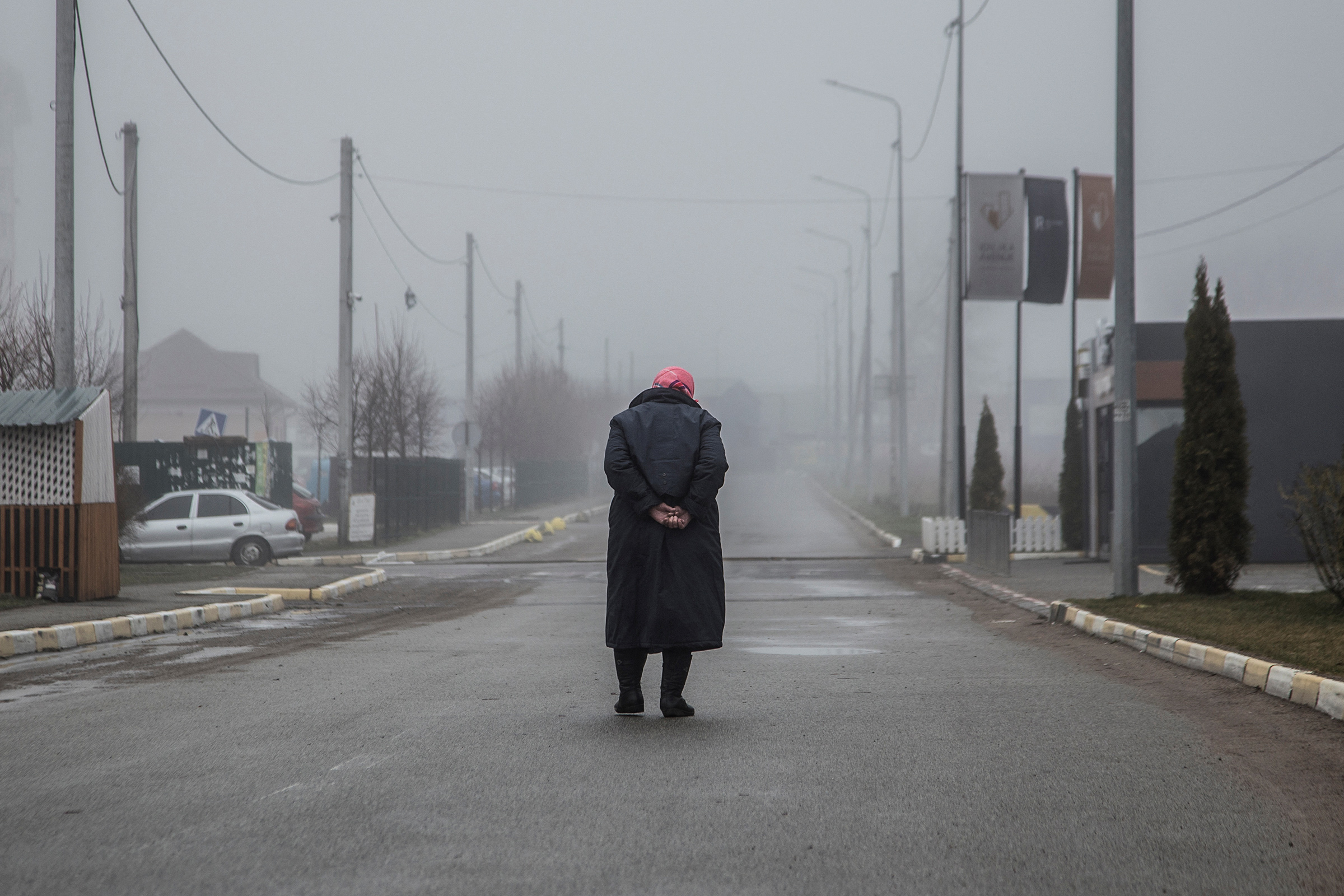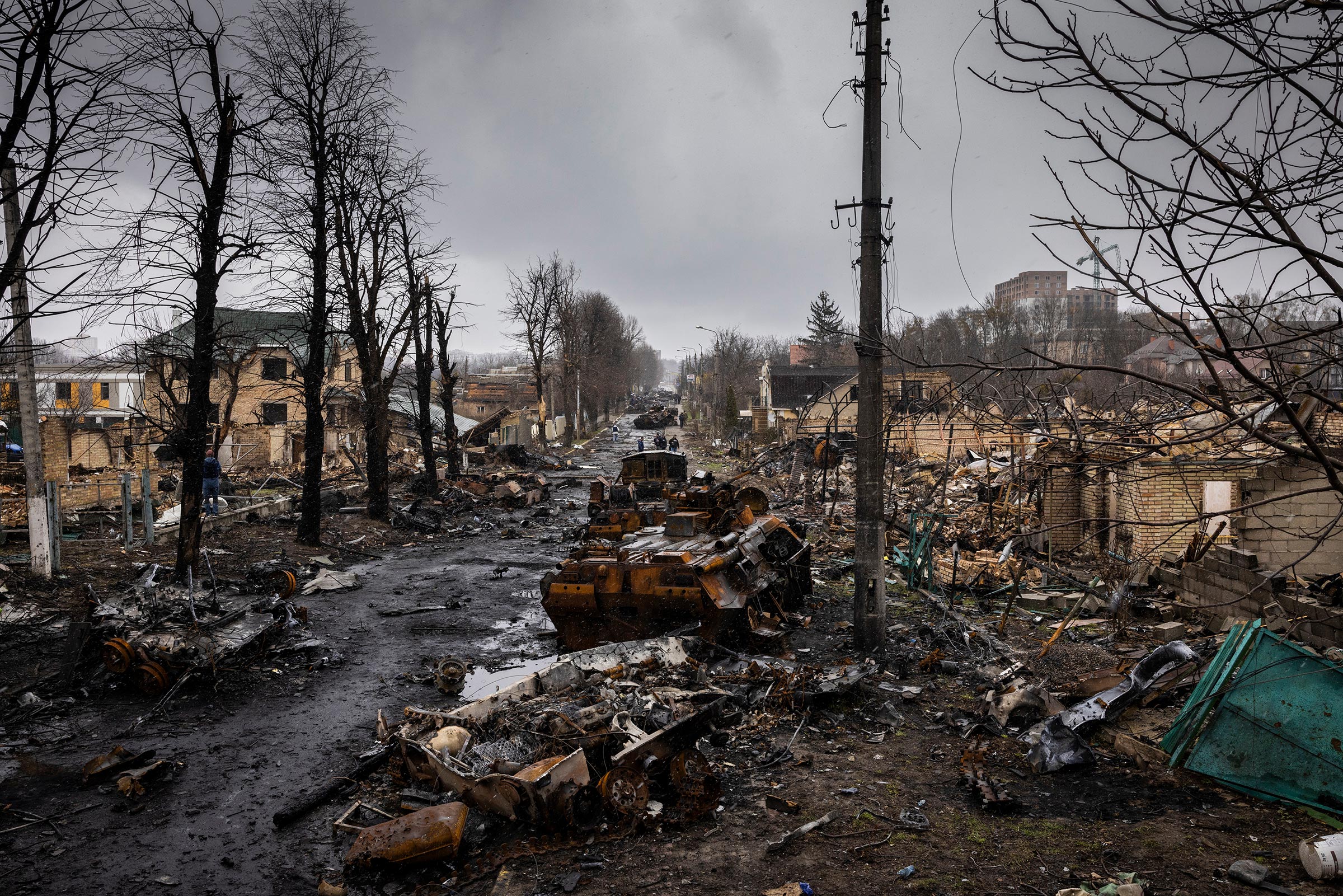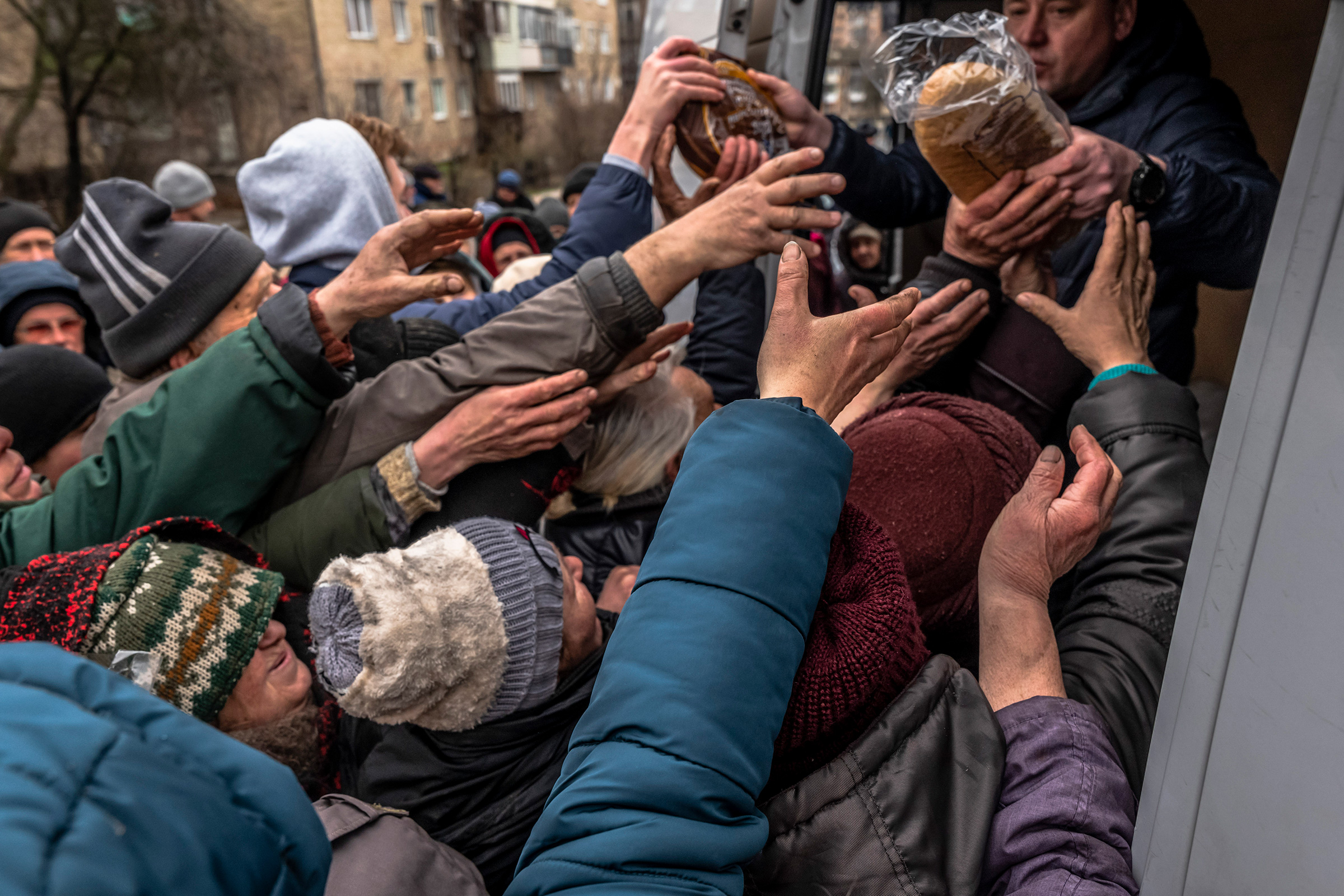
As she lay dying in a North London hospital, my grandmother started to hallucinate scenes from her Ukrainian childhood. All around the ward she saw starving children, skeletal, collapsing in the long, white, strip-light corridors—lying, leaning, barely breathing by the hospital beds. At first my mother and I couldn’t understand what she was referring to. What children? There were only old people in the ward.
Then we realised Galina Ivanovna was surrounded by suppressed memories from her childhood. She was back on Sumska, the elegant high street of her hometown of Kharkiv. She was back in 1932, the height of Stalin’s man-made famine meant to break the resistance of the Ukrainian peasantry to his rule. His victims were staggering from the countryside into the city in search of food, their dead bodies scattered across the dusty road.
Today dead bodies are scattered along Sumska again. Kharkiv’s residential areas are under merciless bombardment. Many more dead civilians lie in the streets of Bucha and Irpin. A conservative estimate puts the number across Ukraine in the mid-1000s so far—with the number rising by the day—and that figure doesn’t include the 5000 who the mayor of Mariupol says perished in his still-besieged city. The murders break our sense of time, of progress. “Can this sort of vicious slaughter of civilians be happening now, in Europe, in 2022?” some ask.
Once again a dictator in the Kremlin is trying to break the spirit of Ukrainians, wipe out the very idea of a sovereign Ukraine.
But this time he is being stopped. The cycle is being broken. This matters not just for Ukraine but for the whole world. For the same reason that Ukraine is the crucible of so much horror in history—it has also produced the ideas, stories, and policies that define good from bad for us all. It will again. It must again.

What we are witnessing in Ukraine is a repeat violation, a repeat abuse.
In the 19th century it was the tsars who banned Ukrainian language books, schools, jailed Ukrainian patriots and dismissed the region as mere “little Russia.” In the 1930s Stalin not only starved (at least) 3.9 million peasants, but also executed Ukrainian intellectuals and artists, many of them in Kharkiv. In the 1970s, my mother’s generation, it was the turn of Ukrainian dissidents to face decade long sentences in “special regime camps” for daring to ask for Ukrainian language rights. Many Ukrainians include the nuclear disaster of Chernobyl in the list of Moscow’s imperial sins: because the reactor was in colonized Ukraine, the argument goes, there was less attention to safety than had it been near the Soviet capital. The sloppiness of the evacuation, the carelessness with which citizens were left uninformed of the risks of radiation before it was too late, would have been less extreme had Chernobyl been down the road from Moscow.
Nor is it just Ukrainians who are continuously oppressed in Ukraine. This is the territory of some of the worst pogroms against Jews in the Russian Empire; the Soviet’s forcible removal of Tatars from their ancestral home in Crimea; the scene of some of World War II’s most death-drenched battles; and the Holocaust. Some 14 million died here through the 20th century in one mass slaughter after another. Ukraine is the crucible of the Bloodlands described powerfully by the Yale historian Timothy Snyder. Perched between so many competing Empires (Russian, Austro-Hungarian, Soviet, Nazi) and rival nationalisms (Polish, Romanian, Hungarian) Ukraine is the place where European great powers are at their most paranoid about insurrection and thus most vicious, and where the ever-changing ruptures in order lead to legal black holes where impossible crimes can momentarily become commonplace.
Read More: What It Will Take for Ukraine to Win the War
But precisely by virtue of being such a concentration of cataclysms, the place where the world’s evils can coagulate, Ukraine is the place which gives birth to its antidotes. Consider Hersh Lauterpacht. He was a lawyer who grew up in Lviv in the early 20th century, surrounded by pogroms, and who lost his parents in the holocaust after the Nazis took the city in 1941. These experiences made him dwell on the need for individuals to have universal rights beyond the power of the state they lived in. An innovative idea that we now take for granted. Lauterpacht came up with the concept of “crimes against humanity,” a charge leveled against the Nazi leadership at the Nuremberg Trials. Another Lviv-educated lawyer, Raphael Lemkin, gave us the ultimate concept to define the depths of evil: genocide, the systemic mass murder of whole groups of people. This revolutionary concept was also used, after much resistance from other lawyers, at Nuremberg. As Anne Applebaum relates in her sublimely violent history Red Famine, Lemkin was first inspired to think about genocide due to the history of the region where he grew up. He considered Stalin’s enforced famine a “classic example of Soviet genocide.”
Writers have also found in Ukraine the great stories that define good and evil. Traveling across territory recently retaken from the Nazis, Vassily Grossman was one of the first to describe the holocaust first-hand in ‘Ukraine Without Jews’. The poet Paul Celan, who heralded from my father’s home town of Chernivtsi, came up with perhaps the darkest and most resonant line about the war in his Death Fugue: “Death is a master from Germany.” The leitmotif of Ukrainian poetry is resilience in the face of oppression. Today in Lviv you can buy pretty pink t-shirts with lines from one of the nation’s most iconic poets, Lesya Ukrainka:
“He who has not lived through a storm/does not know the price of strength.”
Meanwhile the nuclear disaster of Chernobyl helped inspire a new era of global environmental awareness, and a whole vision of our era as defined by the struggle with disastrous man-made changes to the environment: the Anthropocene.
Perhaps in part because of its proximity to Western Europe, Ukraine is the place where global disasters get more visibility, where they come into focus. Most of the crimes listed above—Nazi, Soviet, ecological, genocidal, humanitarian—are not purely Ukrainian but take place across the world. But while elsewhere they might go nearly unnoticed, in Ukraine they bump up close against a set of legal, academic, cultural, and media institutions that force us all to start to make sense of them and look for solutions to them. And this is also what is happening today.

At approximately 1 AM on the fourth week of Russia’s latest invasion of Ukraine I slipped out of my Lviv hotel room and made my way to the train station. It was curfew, and the city was pitch dark and utterly empty. Lviv is so beautifully preserved, its just-rightly jaded art nouveau buildings give such a well-worn patina of time, that you never know what century you are in. On this curfew night I could have been in any century. Lemkin and Lauterpacht were on my mind, and I shared their city.
I was on my way to Kyiv for an editorial meeting on a new project on war crimes I’m working on with the great war reporter Janine di Giovanni to record testimony and tell stories about the Kremlin’s crimes in Ukraine. The project will both produce material for transitional justice, but also create an archive that journalists, documentary film-makers and playwrights, photographers and policy makers can use to tell this story further. But as the train rumbled through the night, with the muffled, gentle, disquieting thuds of artillery fire as we approached the capital, I struggled to define what specific “rights” and what larger “story” we would tell. Was the Russian bombardment of of civilians a war crime? Most likely. But in captured cities there were also many disappearances, murders, executions: more human rights abuses than war crimes. Though I didn’t know it at the time, a few kilometres away from Kyiv, in Bucha, Russian soldiers were likely executing and raping civilians indiscriminately and what could well be strategically: to break the town’s will. Soon the world would know what had happened there and many would be calling this a potential “crime against humanity.”
But none of these categories seem satisfactory. Putin’s speeches and Russia’s actions were aimed at far more than just killing and maiming. Putin has made it perfectly clear that he doesn’t think Ukraine is a real country, that any Ukrainians who think of it as a sovereign state with its own distinct culture are actually ‘Nazis’ controlled by America and who need to be eliminated. Like in the 1930s, there are reportedly kill lists with the names of activists, cultural figures, politicians. Whole chunks of the population of captured cities like Mariupol are being shifted to Russia. History, reality, memory are being destroyed and rewritten. Putin and his spin doctors propose rewriting the story of Ukraine, its people, their lives and their right to define their own meaning. Children will be taught “alternative” facts where truth will be turned upside down; Russia will be the “liberator.” Moscow will even hold a new “Nuremberg” to punish Ukrainians they claim are guilty of war crimes—and ignoring their own.
Read More: What Putin’s Nazi Talk Reveals About His Plans for Ukraine
Such mass reordering of reality, obliteration of memory and history feels far beyond mere ‘war crimes’. It can even sound closer to Lemkin’s original concept of genocide, where he spoke of different kinds of genocide: “political, social, cultural, economic, biological and physical.” He also listed the techniques which could be used to commit genocide, including among them the desecration of cultural symbols and the destruction of cultural centres such as churches and schools. But his final legal definition was reduced to attacks on ethnic and ‘biological’ groups. The human rights lawyer Philippe Sands, who authored the authoritative book, East West Street, on Lemkin and Lauterpacht, told CNN he thinks proving genocide unlikely. He prefers the charge of war of aggression: the whole war is illegal as it is completely unprovoked. Such a charge means that Russian political leaders, and not just soldiers, will be in the dock.
The best term of what Putin is up to I actually heard came from a friend who had campaigned endlessly to stop Russia’s atrocities in Syria. What was under attack, she argued, was the “right to exist.” This may be legally hazy, but for me it captured the essence of Putin’s wars in Chechnya, Syria and now Ukraine, as well as his oppression inside Russia. His aim is always to take away the right of people to define who they are, their future, their meaning. He wants to control not just who lives and dies—but reality itself. And he wants to destroy every vestige of humanitarian and human rights law: because impunity is true power.

The next day I met with my colleagues, a team of Ukrainian journalists lead by the irrepressible Natalia Gumenyuk, in Kyiv’s only open restaurant. Fittingly it was a Crimean Tatar place: a symbol of how the Tatars, deported by Stalin to Siberia in the 1940s, have returned and flourished. The city of my birth (in which I only lived the first nine months of my life) was empty, tense, torn by the undulating screams of sirens. “The noise of the sirens follows you everywhere,” one colleague told me, “into the bedroom, the bathroom. You can’t escape it. And you can’t tell where it’s coming from, it’s all around you. Children are traumatised by it—they cry every time it starts.”
As we discussed our editorial strategy it became clear we had to tell more than just the stories of one war crime or another. To really respond to the totality of Putin’s attack we have to connect what is happening today to the violations from the historical past, to show how they repeat over and over; we have to tell not just the stories of people hurt and killed by the war, but also the culture and everyday life Putin is trying to wipe out; and we have to connect Putin’s crimes in Ukraine with those in Syria, Chechnya, and across the world, including to those committed by other powers.
The aim of our project is to ensure justice: both in actual courts and the court of public opinion. But looking beyond it, perhaps out of this human story about good and evil, about the right to exist, flows another one: a way to think about political action. The ideas of Lemkin and Lauterpacht provided the basis for doctrines like humanitarian intervention and the responsibility to protect. These doctrines argued that when crimes against humanity became extreme and even genocidal, the international community has a duty to intervene.
I have many friends, especially Ukrainians, who have been crying out for something similar in Ukraine. But confronting a nuclear power directly with military force seems a taboo too far for America and its allies. There will, however, be more challenges like Russia’s invasion of Ukraine. Even as it stumbles, Moscow is not done with its Imperial games; China is eyeing Taiwan; India and Pakistan boils and bubbles. America and its allies ad-hoc reaction to the invasion of Ukraine has the embryo of something more strategic, that could work in a world where nuclear powers are again in competition, as in the Cold War, but unlike the latter half of the 20th century these powers are economically interdependent. Western allies have responded to the invasion with a mix of economic sanctions, political pressure, communication efforts, and arming Ukraine in a haphazard, ad-hoc way. This should be formalized.
In the face of war crimes, in response to attacks on “the right to exist” and wars of aggression, we need a system of alliances that can respond immediately and strongly with all political and economic means, and with a clear model for arming our friends. We shouldn’t even be debating whether an oil and gas embargo should kick in after an atrocity like Bucha. It must be automatic. That means utterly rethinking how we connect security, human rights, and economics, to make sure democracies are never as dependent on criminal regimes as Germany has become on Russian energy. It means moving to clean energy much faster, to liberate ourselves from the Russias and Saudis of this world. It will mean strengthening relationships with the militaries of countries like Ukraine, so that they can be armed accordingly.
In short the invasion of Ukraine should mean a new understanding of why and how democracies can act together, quickly and ruthlessly, to compete with the aggressive actions of a Russia or a China. The dictatorships will no doubt form their own networks, and that could lead to a new type of mutual deterrence and a chance at stability.
Once again, Ukraine is making us rethink our values, our laws, our policies, our defense. This war is not just a problem you can localize to Russia-Ukraine. There’s an increasingly coordinated network of dictatorships and soft authoritarians who think the 21st century belongs to them. Working out how to help Ukraine win is the first step to fathom this defining question. As so many times a global fault-line in our thinking, one that we wanted to ignore, is being made apparent in Ukraine. The Ukrainian writer Igor Pomerantsev once defined poetry as a bat flying through the night suddenly illuminated in the flashlight of our focus. That metaphor can apply to politics as well. Ukraine is the place where the invisible is surfaced, where the suppressed will be remembered, where horror is made into meaning. For their freedom and ours.
More Must-Reads from TIME
- Where Trump 2.0 Will Differ From 1.0
- How Elon Musk Became a Kingmaker
- The Power—And Limits—of Peer Support
- The 100 Must-Read Books of 2024
- Column: If Optimism Feels Ridiculous Now, Try Hope
- The Future of Climate Action Is Trade Policy
- FX’s Say Nothing Is the Must-Watch Political Thriller of 2024
- Merle Bombardieri Is Helping People Make the Baby Decision
Contact us at letters@time.com